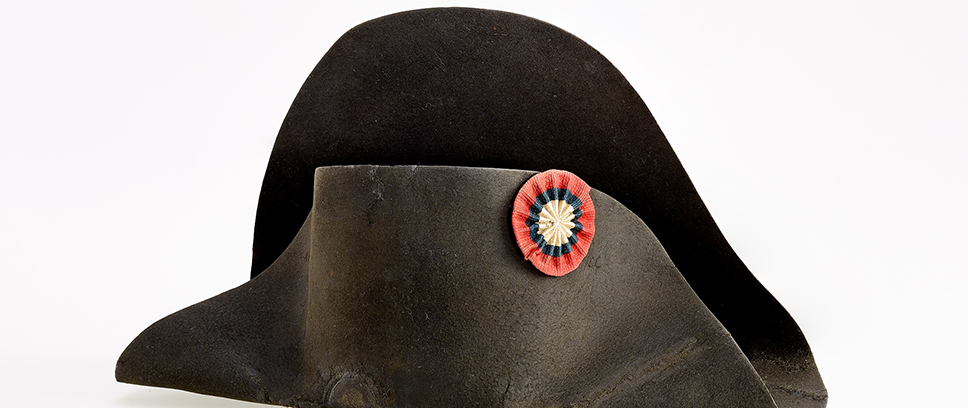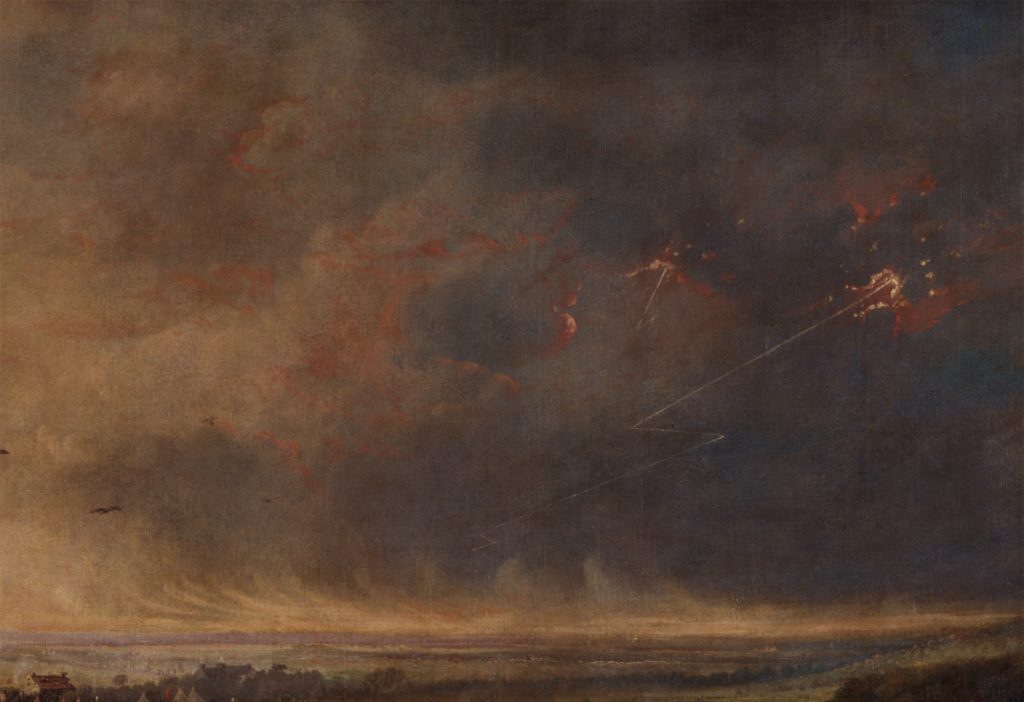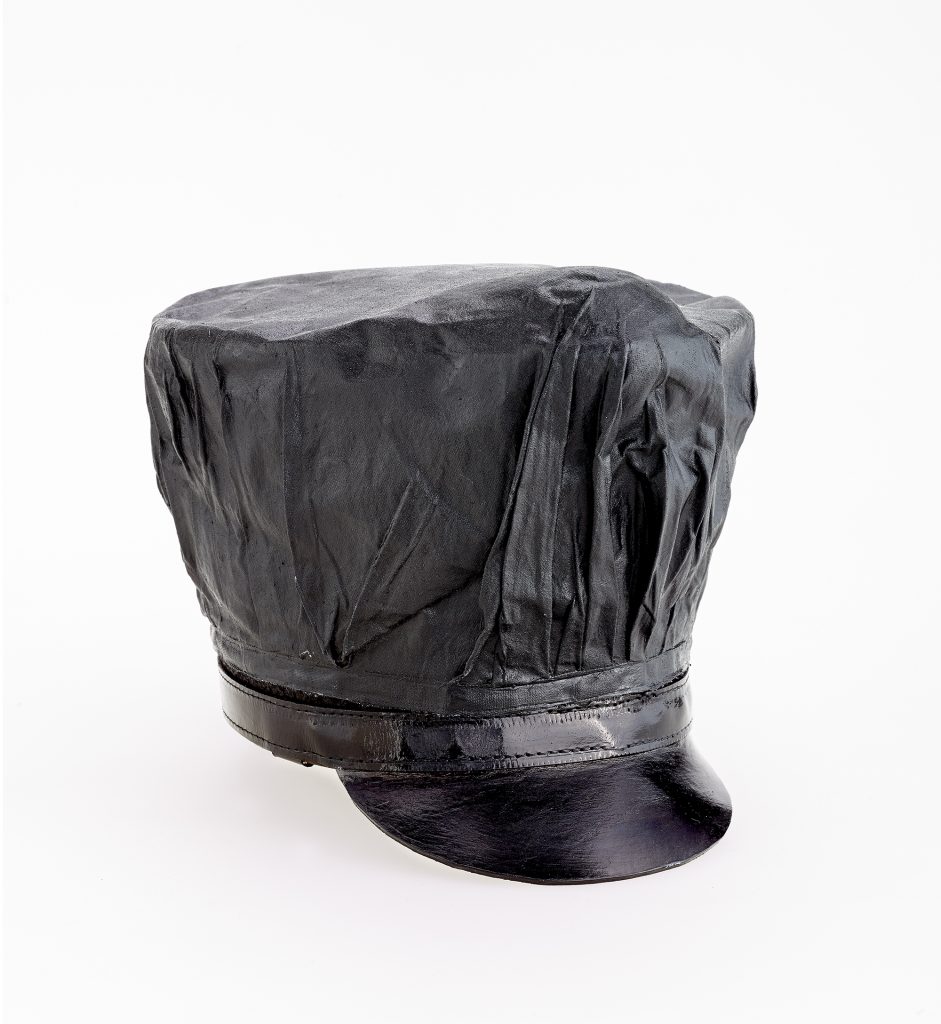
Napoleon’s Wet Hat
Dr. Thomas Weißbrich | 13 December 2023
A glance at the collections of the Deutsches Historisches Museum reveals the immense variety of objects that are related to different epochs and topics of German history. They tell stories of our past or current lives, of famous or often unknown persons and events. In our new blog series #Umweltsammeln (#Environmentcollecting) we present various objects that have to do with the topic of “environment”. Unexpected questions raised by the heads of the different collection sections open new perspectives on historical objects and often reveal startling parallels to questions that deal with our current world.
Dr Thomas Weissbrich, head of the DHM militaria collection, uses a particular object in our collection to tell us about the influence of the weather on one of the most famous battles in European history: It is about the hat that Emperor Napoleon wore during the Battle of Waterloo on 18 June 1815.
Weather makes history
“If it had not rained between the 17th and 18th of June, 1815, the future of Europe would have been changed; a few drops of rain tipped the scales of destiny against Napoleon.”1 With this dramatic assertion Victor Hugo has the narrator of his novel “Les Misérables” (1862) comment on the defeat of Napoleon’s French army at the Battle of Waterloo in 1815. The weather did, in fact, affect the outcome of this battle, which was so important for European history.2 Military historians are still speculating on the degree to which the rain influenced the defeat or victory of the two sides.3
In attempts to plan military actions, the weather was (and still is) an unpredictable factor. It is one of the “frictions” about which the Prussian officer and military theoretician Carl von Clausewitz remarked that it constitutes the difference between plan and reality. Battles and sieges take place in sun or rain, under dark clouds or in strong wind, in the heat of summer or at sub-zero temperatures – in 1588 a storm severely damaged the Spanish Armada in its attempt to invade England; in 1812 “General Winter” forced the “Grande Armée” to retreat from Russia; and in 1944 the Allies had to delay the landing in Normandy due to inclement weather.4 However, adequate attention is seldom paid to such climatic influences in historical representations, which instead tend to concentrate on the military confrontations.
Rain before the battle

It was not just a “few drops of rain” that fell on the plain near the Belgian town of Waterloo. It was in fact a heavy storm followed by a relentless downpour that lasted from the evening of 17 June to the early hours of the morning of 18 June 1815.5 Witnesses reported on flash floods and even the weather-seasoned British stressed the unusual force of the rainfall. The unpaved roads over which the 185,000-strong armies marched towards Waterloo soon turned into muddy trails covered with puddles. Weighed down by their backpacks, the infantrymen stomped through the sludge, their shoes often getting stuck in the mud. The cavalry horses and the cart horses hauling the heavy cannons and munition wagons sank deep into the muck.
Oilcloths and rain covers

In the early 19th century, hardly any protective clothing was provided against bad weather – such was the case with the armies gathered at Waterloo, both the French and the coalition of British, Dutch and Prussian armies. As headgear many soldiers wore a so-called shako made of felt and reinforced with leather. To protect against moisture it could be covered with an oilcloth, which made it more durable. The uniforms were made of woollen cloth, the jackets and trousers cut narrow to save expenses. The wool grease repelled the raindrops for a while, but this natural protection against moisture no longer functioned in heavy rain. The clothing soon became wet and thus heavy. If the material was not properly dyed, the colour could drain out. Overcoats offered a certain protection against soakage, but they had only recently been added to the soldiers’ accoutrements.
The quality of the clothing and equipment differed from unit to unit. While the elite soldiers and the imperial Old Guard were well-equipped, the other units were not, so that the Prussian territorial regiments suffered from their often improvised furnishings.
The moisture could also render the firearms unusable. If the paper cartridges of the flintlock rifles and pistols or the black powder and match cords of the cannons got wet, they were useless until they dried out. Ammunition was therefore stored in leather bags, larger supplies in wooden crates. For protection the sensitive gunlocks were wrapped in cloth. Prussian soldiers were equipped with a rain cover made of leather, which was bound around the flintlock.6
Encampment and inn

By the time the troops of the armies had gathered near Waterloo, most of the soldiers had arrived after long marches.7 Many infantrymen were exhausted from 15-kilometre treks, carrying 30 kilos of equipment on their backs. In the rainy night of the 15th to the 16th of June, only a few of them found shelter in barns or at farmsteads such as the estate La Haye Sainte. The majority bivouacked outdoors, as usual, where they pitched their tents. If dry wood was available, they built campfires for warmth and to prepare food and warm beverages. But because the enemy forces camped nearby, it was sometimes forbidden to light fires for reasons of security. Many soldiers had to sleep in damp uniforms with only a coat as a blanket. There was almost no opportunity to dry the clothes.
By contrast, high-ranking officers were put up in houses, befitting their social class. Wellington and his entourage moved into an estate, while Napoleon and his staff stayed at a farmstead near Waterloo. There the emperor drafted his battle plan for the following day. Among the clothing that was already drenched before the battle began were his grey coat and hat. Since the commander habitually carried several extra hats with him, he exchanged the wet hat for a dry one. He sent the damp bicorne to his hatmaker Poupart in Paris to be refurbished.8
The British Lieutenant General Sir Thomas Picton presented an unaccustomed sight: he appeared on the battlefield in fashionable civilian dress with a top hat – the luggage with his uniform had disappeared on the way to Belgium. In view of the weather conditions, he had also brought along an umbrella, which he used in place of a sword to direct his troops in the field. Apart from the fact that an umbrella was a highly unusual object in the hands of a seasoned officer, this protection against the rain, first invented in the 18th century, was long considered a typical accessoire for ladies.
The downpour also influenced the preparations for the battle on the following morning. It was only with great effort that the French artillery could only be dragged across the sodden earth. The battle therefore first started at noontime, much later than Napoleon had anticipated. This delay endangered his plan to defeat the British-Dutch troops under Wellington before they could be joined by the Prussians under Field Marshal General Blücher. It was late afternoon when Blücher’s troops arrived at the battlefield and the British were already in desperate straits. It was only with the joint forces that the French emperor’s troops could be routed.
Napoleon’s dry hat

After the defeat at Waterloo, Napoleon withdrew to Brussels. On the way he abandoned his carriage and continued on horseback because the coach was in danger of getting stuck in the muddy roads. This fear was not unfounded, because the carriage got caught in a jam in the village of Genappe as the French forces retreated. There, Prussian fusiliers captured the empty coach and its contents, including a hat that had been left behind. Blücher sent the hat and further booty to the Prussian King Friedrich Wilhelm III in Berlin as trophies. Napoleon’s bicorne was first displayed in the Royal Art Chamber in the castle, conserved in a glass showcase, and later shown in different museums.9
After Napoleon’s defeat and abdication, he was banished to St. Helena. On this island in the South Atlantic the exiled emperor was subject to an average humidity of 85 percent. There he no longer wore a black felt hat, but, more fittingly, a straw sun hat.
1 As quoted in https://www.projekt-gutenberg.org/hugo/elenden2/chap001.html Erstes Buch. Waterloo, III. Am 18. Juli 1815
2 Cf. https://www.dhm.de/lemo/kapitel/vormaerz-und-revolution/wiener-kongress/schlacht-bei-waterloo.html; Marian Füssel, Waterloo 1815, München 2015.
3 Cf. Stephen Clarke, How the French won Waterloo (or think they did), London 2015, pp. 54-60.
4 Cf. Jan Klage, Wetter macht Geschichte. Der Einfluss des Wetters auf den Lauf der Geschichte, Frankfurt a.M. 2003.
5 Cf. J. Neumann, Great Historical Events That Were Significantly Affected by the Weather. Part 11: Meteorological Aspects of the Battle of Waterloo, in: Bulletin of the American Meteorological Society, 73 (1993), pp. 413-420.
6 Cf. http://www.5-preussische-brigade.de/wb/pages/militaer-allgemein/ausruestung/allgemeine.php#dinge
7 Cf. John Keegan, Das Antlitz des Krieges, Düsseldorf / Vienna 1978, pp. 154-159.
8 For almost 100 years the hat remained in the family of the hatmaker as a relic and now belongs to the collection of the Musée Sens. Cf. https://www.musees-sens.fr/les-collections/salle-napoleon/
9 In 1883 the hat was transferred from the Royal Art Chamber to the Prussian Army Museum, which was located in the Zeughaus. When the monarchy was dissolved in 1918, the Zeughaus became part of the state museums, then the Army Museum of the Wehrmacht, followed by the central history museum of the GDR, the “Museum für deutschen Geschichte”, whose collections, including the hat, were transferred in 1990 to the Deutsches Historisches Museum.